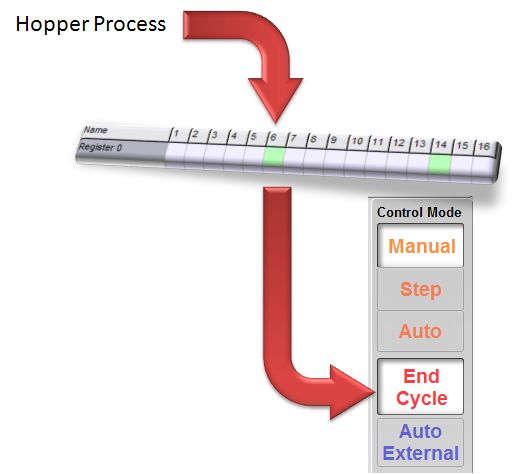Difference between revisions of "CNC Bender v11-20090826"
| Line 17: | Line 17: | ||
In this example the Hopper secondary process detected a problem and set point 6 to "active" in that register.<br><br> | In this example the Hopper secondary process detected a problem and set point 6 to "active" in that register.<br><br> | ||
| − | + | This is how the feature was setup: | |
| − | + | * A CIO name is defined in the CIO dictionary as "Input_EndCycleMode_Active" and is defined as point 6 in an actual input module or IBR (an internal virtual module). | |
| − | Because the name is defined in both CNC Bender | + | * Next, the new CIO name was added to the CNC Bender Low Level options. |
| − | + | * Because the CIO input name is defined in both places, CNC Bender will monitor the state of that CIO and change the state of the End Cycle Mode whenever input state changes. | |
</td> | </td> | ||
<td> | <td> | ||
Revision as of 20:45, 26 August 2009
 NEW - END CYCLE Mode Can Be Controlled By External Processes
NEW - END CYCLE Mode Can Be Controlled By External Processes
Since CNC Bender can run scores of processes simultaneously, the END CYCLE mode is "tail-out" feature that allows all the processes to pause at the end of running the cycle in order to allow an orderly shut-down of all mechanisms controlled by CNC Bender. This would especially apply to hoppers, loaders of all types, unloaders, and other secondary processes that run around the machine.
CNC Bender used to control the End Cycle mode from within the CNC Bender interface only in the control mode bar (on the right side of the screen).
Now CNC Bender monitors a programmable CIO input (in Low Level) that can also change the End Cycle mode from a processlist or an external computer. The process simply changes the point state being monitored, and the mode button in the main CNC Bender screen set itself to the state automatically.
|
In this example the Hopper secondary process detected a problem and set point 6 to "active" in that register. This is how the feature was setup:
|
Other Pages
- Back to CNC Bender
- Back to CNC Bender Software Updates
- Read about Push Bending
- Read about Push Bend Profile Tables


